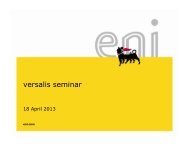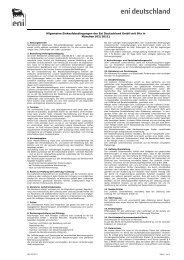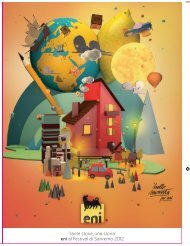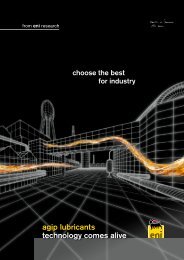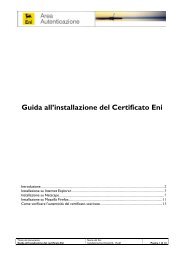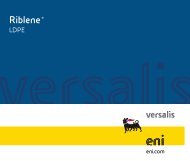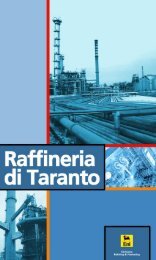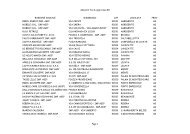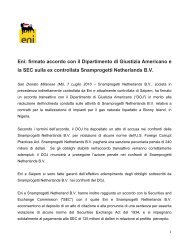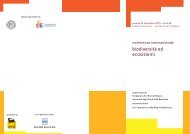È in corso il restauro conservativo del Duomo di Milano. Un ... - Eni
È in corso il restauro conservativo del Duomo di Milano. Un ... - Eni
È in corso il restauro conservativo del Duomo di Milano. Un ... - Eni
Create successful ePaper yourself
Turn your PDF publications into a flip-book with our unique Google optimized e-Paper software.
FRONTIERE - FRONTIERS<br />
E così Sia<br />
Social impact assessment<br />
è la risposta a un problema<br />
sempre più attuale: gestire<br />
gli <strong>in</strong>terventi <strong>in</strong>dustriali<br />
<strong>in</strong> contesti complessi.<br />
Grazie a nuovi strumenti tecnici<br />
e partecipativi, come<br />
quelli messi a punto da <strong>Eni</strong>.<br />
<strong>di</strong> MARCO STAMPA e STEFANIA SANTOMAURO<br />
70<br />
L ’INDUSTRIA<br />
PETROLIFERA IN QUESTI ANNI SI<br />
trova ad affrontare sfide sempre più importanti, non<br />
solo da un punto <strong>di</strong> vista f<strong>in</strong>anziario, organizzativo e<br />
tecnologico, ma anche, e soprattutto, da quello <strong>del</strong>la<br />
sostenib<strong>il</strong>ità <strong>del</strong> bus<strong>in</strong>ess.<br />
Date le caratteristiche <strong>del</strong> settore, le imprese non possono<br />
scegliere <strong>di</strong> localizzare le attività laddove i fattori produttivi<br />
presentano le migliori con<strong>di</strong>zioni <strong>di</strong> ren<strong>di</strong>mento e produttività,<br />
come avviene per l’<strong>in</strong>dustria manifatturiera. Esse devono<br />
pianificare gli <strong>in</strong>vestimenti <strong>in</strong> base alle conoscenze geologiche<br />
e ai risultati <strong>del</strong>l’attività esplorativa, trasferendo uom<strong>in</strong>i<br />
e mezzi nelle aree dove si ritiene che siano presenti e sfruttab<strong>il</strong>i<br />
i giacimenti <strong>di</strong> idrocarburi, raggiungendo spesso località<br />
remote per perio<strong>di</strong> molto lunghi. Ci si trova qu<strong>in</strong><strong>di</strong> <strong>di</strong><br />
fronte alla doppia sfida <strong>di</strong> doversi <strong>in</strong>tegrare <strong>in</strong> un tessuto sociale<br />
ed economico locale evitando <strong>di</strong> apportarvi effetti negativi<br />
e al tempo stesso contribuendo al suo sv<strong>il</strong>uppo.<br />
<strong>Eni</strong>’s Way<br />
<strong>Eni</strong>’s Way<br />
LA COMPLESSITÀ NEL BUSINESS.<br />
Per un’azienda come <strong>Eni</strong>, attiva<br />
<strong>in</strong> oltre 70 paesi, è determ<strong>in</strong>ante<br />
operare <strong>in</strong> collaborazione<br />
con le autorità nazionali e locali<br />
e <strong>in</strong>staurare con le popolazioni<br />
un <strong>di</strong>alogo che tenga conto<br />
dei loro bisogni e aspettative.<br />
Accanto, una bamb<strong>in</strong>a kazaka.<br />
Nel paese l’<strong>Eni</strong> ha realizzato<br />
numerosi <strong>in</strong>terventi nel campo<br />
<strong>del</strong>lo sv<strong>il</strong>uppo sociale:<br />
costruzione e ristrutturazione<br />
<strong>di</strong> scuole, centri culturali<br />
e sportivi, strade, piazze<br />
ed e<strong>di</strong>fici abitativi.<br />
BUSINESS COMPLEXITY.<br />
For a company like <strong>Eni</strong>, which<br />
is active <strong>in</strong> more than 70 nations,<br />
it is crucial to work <strong>in</strong> cooperation<br />
with national and local authorities<br />
and establish with the population<br />
a <strong>di</strong>alogue tak<strong>in</strong>g <strong>in</strong>to account their<br />
needs and expectations. Alongside,<br />
a kazakh girl. In Kazakhstan <strong>Eni</strong><br />
has carried out many plans<br />
<strong>in</strong> the field of social development:<br />
construction and rehab<strong>il</strong>itation<br />
of schools, cultural and sports<br />
centres, roads, squares and houses.<br />
Diventa cruciale, pertanto, comprendere a fondo <strong>il</strong> contesto<br />
locale nei suoi aspetti sociali, economici e culturali per valutare<br />
le possib<strong>il</strong>i ricadute <strong>del</strong>le attività <strong>di</strong> esplorazione e produzione,<br />
massimizzando gli effetti positivi e riducendo al m<strong>in</strong>imo<br />
quelli negativi. Si pensi, ad esempio, alla necessità <strong>di</strong><br />
gestire l’impulso all’economia locale che generalmente deriva<br />
dallo sv<strong>il</strong>uppo <strong>di</strong> un progetto e che pur offrendo gran<strong>di</strong><br />
opportunità porta con sé alcuni rischi <strong>di</strong> <strong>di</strong>storsione economica<br />
come, ad esempio, quella che gli economisti def<strong>in</strong>iscono<br />
“dutch <strong>di</strong>sease” (la cosiddetta “malattia olandese”, un fenomeno<br />
dovuto alla scoperta <strong>di</strong> risorse naturali, alla quale<br />
segue un rafforzamento <strong>del</strong>la valuta locale che, rendendo i<br />
prodotti nazionali meno competitivi, porta a una progressiva<br />
de<strong>in</strong>dustrializzazione <strong>del</strong>l’economia nazionale; <strong>il</strong> term<strong>in</strong>e è<br />
stato coniato <strong>in</strong> Olanda dopo la scoperta dei giacimenti <strong>di</strong><br />
gas nel Mare <strong>del</strong> Nord).<br />
Altro fenomeno ricorrente e fonte <strong>di</strong> problemi è quello <strong>del</strong><br />
AMEN TO SIA<br />
Social impact assessment is the response<br />
to a problem of ever grow<strong>in</strong>g <strong>in</strong>terest:<br />
that of manag<strong>in</strong>g <strong>in</strong>dustrial projects<br />
<strong>in</strong> complex contexts.<br />
Thanks to new technical and participative<br />
tools like those developed by <strong>Eni</strong>.<br />
by MARCO STAMPA e STEFANIA SANTOMAURO<br />
THE OIL INDUSTRY IN THESE YEARS FINDS ITSELF<br />
hav<strong>in</strong>g to deal with challenges that are becom<strong>in</strong>g<br />
progressively more important, not only from a f<strong>in</strong>ancial,<br />
organizational and technological po<strong>in</strong>t of view, but also<br />
and especially from that of the susta<strong>in</strong>ab<strong>il</strong>ity of the bus<strong>in</strong>ess.<br />
Given the nature of the <strong>in</strong>dustry, enterprises cannot choose to<br />
locate their activities where productive factors present the most<br />
ideal con<strong>di</strong>tions for yield and productivity, as the manufactur<strong>in</strong>g<br />
<strong>in</strong>dustry can. They have to plan their <strong>in</strong>vestments based on<br />
geological knowledge and the results of exploration, mov<strong>in</strong>g<br />
workers and equipment <strong>in</strong>to the areas where they believe<br />
hydrocarbon fields are to be found and can be put to use, tak<strong>in</strong>g<br />
them often to remote areas, and often for very long periods. And<br />
so, there is both the challenge of need<strong>in</strong>g to <strong>in</strong>tegrate <strong>in</strong>to a local<br />
social and economic fabric without produc<strong>in</strong>g negative effects<br />
and that of contribut<strong>in</strong>g to its development.<br />
Therefore, it is crucial to have an <strong>in</strong>-depth knowledge of the local<br />
context <strong>in</strong> its social, economic and cultural aspects <strong>in</strong> order to<br />
evaluate possible effects of exploration and production activities<br />
and maximize the positive ones wh<strong>il</strong>e reduc<strong>in</strong>g to the lowest<br />
possible level the negative ones. Take, for example, the need to<br />
manage the stimulus to the local economy which generally<br />
derives from the development of a project. Though enta<strong>il</strong><strong>in</strong>g great<br />
opportunities, it also br<strong>in</strong>gs with it some risk of economic<br />
<strong>di</strong>stortion like, for example, what economists call the “Dutch<br />
<strong>di</strong>sease”, an experience due to the <strong>di</strong>scovery of natural<br />
resources, result<strong>in</strong>g <strong>in</strong> a strengthen<strong>in</strong>g of the local currency<br />
which, mak<strong>in</strong>g national products less competitive, then leads to a<br />
progressive de-<strong>in</strong>dustrialization of the national economy. The term<br />
was first used <strong>in</strong> Holland after the <strong>di</strong>scovery of natural gas fields<br />
<strong>in</strong> the North Sea.<br />
Another recurr<strong>in</strong>g phenomenon and a source of problems is that<br />
of the “boom-bust” (the large demand for workers – the boom –<br />
<strong>in</strong> the early phases of the project, when <strong>in</strong>frastructures are<br />
prepared, and the successive demob<strong>il</strong>ization – the bust – at the<br />
end of the construction phase) which, if managed badly, can have<br />
negative social aftereffects. First, it is necessary to organize the<br />
large-scale migration flow from <strong>di</strong>fferent areas of the country<br />
towards the location <strong>in</strong>volved <strong>in</strong> the project. Then it is necessary<br />
to manage the <strong>in</strong>tegration of the temporary immigrants, as well<br />
as that of the hundreds of foreign workers employed by o<strong>il</strong><br />
companies, <strong>in</strong>to the local communities. And, f<strong>in</strong>ally, it is<br />
necessary to get ready to provide new jobs for the workers at the<br />
end of the plant-construction phase, <strong>in</strong> order to avoid large-scale<br />
return to unemployment afterwards, with the obvious social<br />
impact it causes. In deal<strong>in</strong>g with these issues, close collaboration<br />
with local and national authorities is obviously necessary.<br />
Alongside these social-economic aspects, there are others<br />
71



